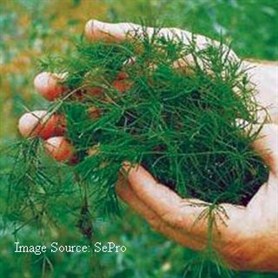
Ecological Importance
Chara (commonly known as Stonewort; Skunkweed; Sandgrass) is an advanced form of algae often mistaken for a plant. Chara stabilizes bottom sediments; provides food for waterfowl and cover for fish. Chara also supports insects and other small aquatic animals, which are important foods for trout, bluegills, small mouth bass, and largemouth bass.
Submerged portions of all aquatic plants provide habitats for many micro and macro invertebrates. Chara is consumed by many species of ducks. Identified by a strong musky odor when crushed and a gritty feeling texture due to calcium deposits on the surface.
Problems
Chara can benefit water quality and clarity. It is a good stabilizer and considered valuable fish habitat. However, due to its ability to grow rapidly, Chara can take over a small pond if left untreated. This can become a problem in that is reduces available fish habitat, clogs intakes on golf course irrigation lakes, makes swimming or boating difficult or reduces the overall aesthetics of a lake or pond when it becomes overgrown.
Plant Description
Chara is often called muskgrass or skunkweed because of its foul, musty almost garlic-like odor. Chara is a gray-green branched multicellular alga that is often confused with submerged flowering plants. However, Chara has no flower, will not extend above the water surface, and often has a "grainy" or "crunchy" texture. Chara has cylindrical, whorled branches with 6 to 16 branchlets around each node.

When removed from water chara will dry out within just a few hours of sunlight exposure appearing ashen to white once dry. Dense growths, attached but not rooted may cover entire bottom of shoreline areas or ponds.
Hints to Identify
Gritty, bristly feel due to mineral deposits on leaf surfaces; emits a strong musky odor when crushed; is sometimes mistaken for coontail or milfoil, but chara has a lighter green color than most other aquatic plants.
|
Homeowner Treatment Options
|
| Cutrine Plus Granular |
| Hydrothol Granular |
| *Aquatic Biologists recommends implementing preventative management techniques and physical removal prior to, or in conjunction with treatment. |
Common Application Questions
Q. When is the best time to treat?
A. Small areas can be hand raked. Chara is a heavy algae type. Treat only if causing nuisance conditions.
Q. How do I actually apply the product(s)?
A. Cutrine Plus granules can be spread by a small hand-held spreader or can be tossed by a hand scoop. A hand held pump up sprayer or Solo backpack sprayer can apply liquids such as Cutrine Plus liquid.
Q. How often do I need to treat?
A. If you catch it early one treatment can last the season. Two or more treatments may be required when chara is mature.
Q. How long before I see results?
A. Generally within six to fifteen days depending upon water hardness and growth cycle things will be cleared up.
